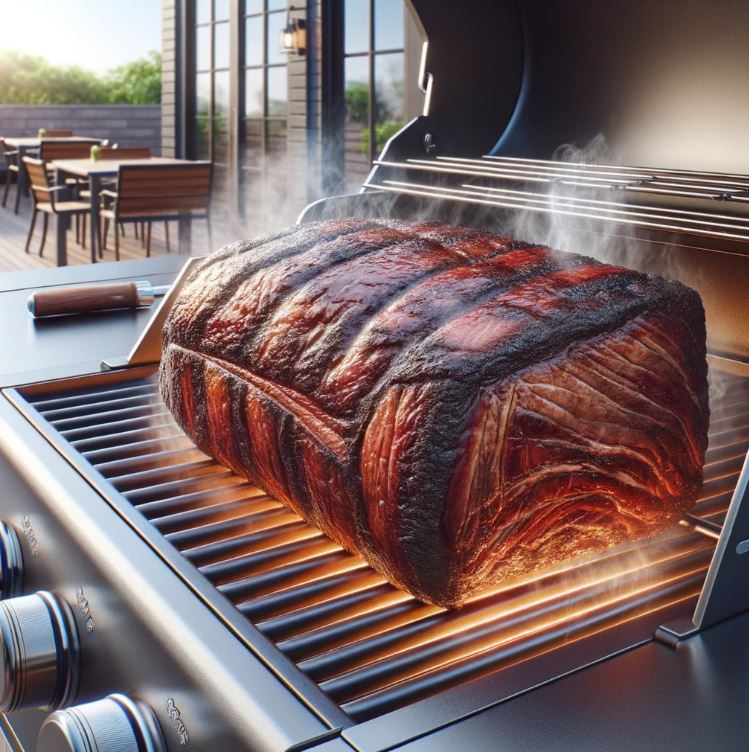I'm a participant in the Amazon Services LLC Associates Program, an affiliate advertising program designed to provide a means for me to earn fees by linking to Amazon.com and affiliated sites.
Cooking brisket on a gas grill can be a rewarding culinary challenge, producing tender, flavorful meat that impresses family and friends. While traditionally smoked, brisket can also be successfully cooked on a gas grill with the right techniques. This comprehensive guide will walk you through everything you need to know about preparing and grilling brisket on a gas grill, ensuring your next barbecue is a delicious success.
Most importantly, you need a great gas grill that can fit and properly cook your brisket. Consider checking out our under $500 gas grill guide for more info.
Key Takeaways – Brisket on Gas Grill
- Choose Quality Meat: Opt for a well-marbled, whole packer brisket for the best flavor and tenderness.
- Season Generously: Use a robust dry rub and let the brisket rest overnight for deeper flavor.
- Maintain Low and Slow Cooking: Keep the grill temperature between 225-250°F and cook for 1 to 1.5 hours per pound.
- Use Indirect Heat: Set up your grill for indirect cooking and add smoke for enhanced flavor.
- Wrap and Rest: Wrap the brisket at 165°F and let it rest after cooking to ensure juiciness.
Choosing the Right Brisket
Selecting Quality Meat
For the best results, choose a brisket with good marbling. Marbling refers to the white streaks of fat within the meat that melt during cooking, adding flavor and tenderness. Look for USDA Prime or Choice grades for superior quality.
Whole Packer Brisket vs. Flat Cut
A whole packer brisket includes both the flat and point cuts, while the flat cut is leaner and more uniform in thickness. For grilling, a whole packer brisket is ideal as it provides more flavor and juiciness.
Preparing Your Brisket
Trimming
Trim excess fat from the brisket, leaving about a 1/4-inch layer. This fat cap helps keep the meat moist during grilling.
Seasoning
Generously season your brisket with a dry rub. A simple mix of kosher salt, black pepper, paprika, garlic powder, and onion powder works well. For added depth, let the seasoned brisket rest in the refrigerator overnight.
Bringing to Room Temperature
Allow the brisket to sit at room temperature for about an hour before grilling. This ensures even cooking throughout the meat.
Setting Up the Gas Grill
Indirect Heat Setup
Set your gas grill for indirect cooking. Light one or two burners on one side of the grill and leave the other side off. Aim for a consistent temperature of 225-250°F.
Adding Smoke
Use a smoker box or create a foil pouch filled with wood chips. Hickory, oak, or mesquite are excellent choices for brisket. Place the box or pouch over the lit burners to generate smoke.
Grilling the Brisket
Placing the Brisket
Place the brisket on the unlit side of the grill, fat side up. Close the lid and maintain the temperature at 225-250°F.
Low and Slow Cooking
Cook the brisket low and slow, allowing 1 to 1.5 hours per pound. Check the grill temperature regularly to ensure it stays within the target range.
Wrapping the Brisket
When the brisket reaches an internal temperature of about 165°F, wrap it in butcher paper or aluminum foil. This step, known as the Texas Crutch, helps retain moisture and speeds up the cooking process.
Finishing the Cook
Continue grilling until the internal temperature reaches 200-205°F. Use a meat thermometer to check doneness. The brisket is ready when it’s tender and a fork can be easily inserted.
Resting the Brisket
Remove the brisket from the grill and let it rest, wrapped, for at least 30 minutes. This allows the juices to redistribute, ensuring a moist and flavorful result.
Recent Developments in Grilling Techniques
Grilling technology and techniques continue to evolve, offering new ways to perfect the art of cooking brisket on a gas grill:
- Smart Thermometers: Advanced thermometers that connect to your smartphone allow for precise temperature monitoring without lifting the grill lid.
- Infrared Grills: Infrared technology provides even, consistent heat, making it easier to maintain the low temperatures required for slow-cooking brisket.
- Eco-Friendly Fuels: Sustainable propane and natural gas options are becoming more available, providing eco-friendly alternatives for outdoor cooking.
Top Experts in the Field and Their Contributions
Aaron Franklin
Aaron Franklin, of Franklin Barbecue fame, is renowned for his brisket expertise. His book, “Franklin Barbecue: A Meat-Smoking Manifesto,” provides invaluable tips and techniques for smoking and grilling brisket.
Link to Aaron Franklin: Franklin Barbecue
Steven Raichlen
Steven Raichlen, a barbecue expert and author of “The Barbecue Bible,” offers extensive knowledge on grilling brisket. His methods emphasize the importance of temperature control and seasoning.
Link to Steven Raichlen: Steven Raichlen’s Barbecue Bible
Meathead Goldwyn
Meathead Goldwyn, founder of AmazingRibs.com, provides a wealth of information on grilling techniques, including detailed guides on cooking brisket on gas grills.
Link to Meathead Goldwyn: Amazing Ribs
For more grilling tips and recipes, check out our articles on Ninja FrostVault vs Igloo, Grill Dinner Ideas, and Leftover Grilled Chicken Ideas. If you’re looking for bold flavors, visit our guide on Craving Spicy Food. Also, explore the benefits of GLP-1 boosting foods for weight loss in our recent article on GLP-1 Weight Loss for Non-Diabetics.
Author
HappyFoodGeek
HappyFoodGeek is an expert in the field of grilling and outdoor cooking with years of experience. Dedicated to bringing the latest tips, techniques, and recipes, HappyFoodGeek aims to inspire and inform readers to achieve culinary excellence in their own backyards.
